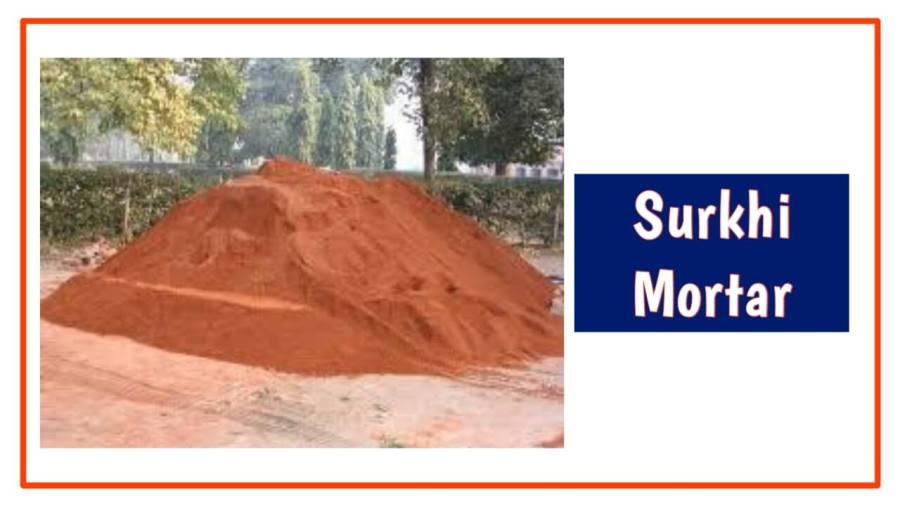Table of Contents
Surkhi is the powdered form of over burnt bricks or clay balls.
Surkhi mortar is prepared by mixing surkhi, fat lime, and water in a suitable proportion.
Surkhi mortar can be prepared in two ways:
a. fat lime + surkhi + water
b. fat lime + surkhi + water + sand ( in small quantity)
✔ In place of sand in a lime mortar; surkhi is utilized to prepare this mortar. So, it is called surkhi mortar.
✔ It should be noted that surkhi is not a chemically inert substance and hence it can’t be used as adulterants with the matrix as cement.
✔ Surkhi mortar is more resistant to alkalis and salt solutions as compared to cement mortar.
Using surkhi mortar for plastering may result in the formation of cracks. Hence, mixing suitable additives or a small amount of sand may be required to add while preparing this mortar.
| Read Also: Surkhi, Types of Surkhi, Uses, Advantages & Disadvantages |
1. History
Evidence has shown that the use of surkhi and surkhi mortar was started before the 2nd century BC. ( Source: IndianExpress NewsPaper)
Surkhi mortar was used even during the 19th century.
In the 19th century, surkhi mortar was used for the construction of masonry in the Upper Ganga Canal in Uttar Pradesh, Vani Vilas Sagar Dam, etc.
2. Strength & Quality of Surkhi Mortar
The mortar prepared from surkhi varies in quality since the raw materials like clay or lime that occurred in nature are widely varying in quality.
The strength characteristics of surkhi mortar depend upon the following:
a. The physical and chemical composition of lime or surkhi.
b. Mineralogical composition of surkhi.
c. Degree of the burning of lime or surkhi.
d. Fineness of surkhi.
e. Mix proportion.
3. Preparation of Surkhi Mortar
(i) Hand mixing:
~This method is usually used when a small quantity of surkhi mortar is needed.
~ In a bucket; the required quantity of surkhi is taken. Then fat lime is added to the bucket.
~ Dry mixing work is done manually. After the uniform color is seen, water is added to the mixture. Water is added in phases.
~ Then mixture is mixed manually. The formed mixture is surkhi mortar.
(ii) Machine mixing:
~ Add half water
~ Add half surkhi
~ Add all the lime
~ Add 1/4 of the water (pour in slowly running down the drum)
~ Add remaining half surkhi/sand
~ Add the rest of the water to get the required consistency.
~ The quantity of water used for the preparation of mortar is adjusted to obtain a workable mortar.
4. Types of Surkhi Mortar
2 types of surkhi mortar are commonly used. They are:
a. Surkhi-Lime Mortar
The mixture of fat lime, surkhi, and water is said to be the surkhi-lime mortar.
b. Surkhi-Lime-Sand Mortar
It is the mixture of fat lime, sand, surkhi, and water in definite proportion.
| Read Also: Cement Mortar & Grades of Cement Mortar |
5. Advantages of Surkhi Mortar
a. There is a global sand shortage. So, surkhi mortar can be used as an alternative.
b. It has a low heat of hydration. Thus doesn’t require curing.
c. It is more resistive to alkalis and salt solutions.
d. It is slow in setting and therefore it can be used for work up to a period of six hours of its preparation without disturbing the efficiency of mortar.
6. Disadvantages of Surkhi Mortar
a. Compared to ordinary mortar, it is more subjected to shrinkage.
b. It has low compressive strength as compared to ordinary cement mortar.
c. It sets slowly.
Important Question
a. Can we use surkhi mortar in permanent constructions? Ans: Yes, we can use surkhi mortar for small-scale to medium-scale permanent structures. Generally, this mortar is not used for large-scale constructions although it was used in the construction of heavy structures in past.
|
| Read Also: Surkhi, Types of Surkhi, Uses, Advantages & Disadvantages |

